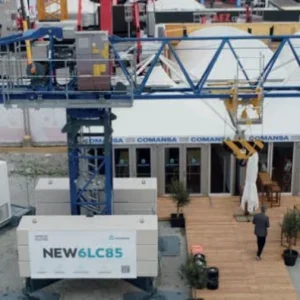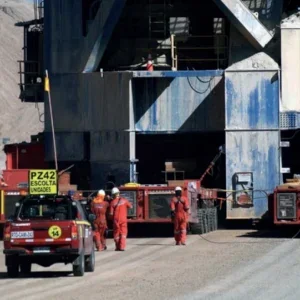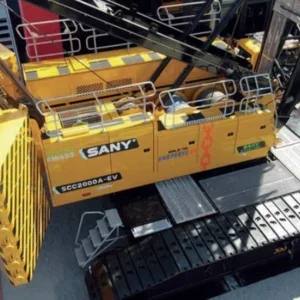Goose-necked crawler cranes, ringer-mounted heavy lifters, an unusual float-mounted lattice boom giant, numerous tracked hydraulic lattice booms, mechanical lattice booms, rough terrain telescopics, smaller float-mounted marine lifters and even one European tower crane are all now at work on the huge Boston Artery scheme, reshaping one of the major cities of the USA’s east coast.
Cranes are busy making just about every kind of lift. They also form the base for a wide variety of special machines from diaphragm wall rigs to auger bore piling rigs to mix-in-place soil drills.
Dozens of contracts make up the Big Dig, $10.8bn of work. About 12km of multi-lane highway is being either built from new or restructured. A key part is sunk in an eight to 10 lane tunnel cut through the busy centre of the historic port and its modern super-high rise downtown area. “Depending on which contractor has hired in which units for work, at any one time there are between 125 and 175 fairly big cranes on this job,” says Dan McNichols, spokesman for the state authority Massachusetts Highway Department which is client for the Central Artery/Tunnel (C/AT) scheme.
Biggest of all is a 600t Demag working on the bridge at the north end of the project. The $200m unit has a 78.5m boom and has been used for lifting in bridge girders. Also at work is a Manitowoc 4100 Ringer with a 95m boom and a maximum reach of 87.5m where it can lift 30 US tons.
The site is a clear demonstration of US lifting culture: lattice boom crawlers dominate. The name Manitowoc is everywhere: 3900s, 4100s, 250s and 888s. American and Link-Belt crawlers are also much in evidence.
A single Potain tower crane can also be seen, having been brought in by Dutch firm Interbeton, the European component of a four firm consortium doing the biggest contract on the project, the $400m northbound side of the huge South Bay interchange. Lead firm Slattery Skanska, though Swedish owned, works more in the US style as do its joint venture partners JF White Contracting and Perini Corperation.
The total job is vast, a complete restructuring of the road system leading out of the downtown area, with removal and rebuilding of several major bridges across highways and a five track railroad line out of the Boston South railway terminus, several variants of temporary and newly installed permanent viaduct and numerous sliproads to connect one interstate to another.
The tower crane, soon to be joined by a second one, is working on the excavation pits where huge concrete boxes are being built for later jacking out underneath the live railway link. Interbeton is working on the complex ground freeze and tunnel box jacking for sections and slip roads of the north-south I-90 Interstate highway which cross under the interstate itself.
The Big Dig’s first element is put underground and out of sight, the north-south I-93 highway which now runs on a notoriously ugly and congested 1950s elevated steel structure. Major excavation is now underway for the main 4km length of eight lane tunnel and various sliproads, taking place within giant 1m- to 1.3m-thick concrete diaphragm walls formed along the route of the old highway. Eventually French-made Soletanche hydrofraises (slurry wall trenching machines) mounted on crawler crane carriers will have formed some 7km of slurry wall.
Loads from the old elevated structure above, still carrying traffic 24 hours a day, are gradually being transferred to big steel beams lifted in across the gap between 30m-deep slurry walls allowing excavation to proceed beneath. Some of this needs delicate lifting: old Boston is close by and historic buildings are only metres away.
The South Bay Interchange, links this I-90 to another east-west link just where the underground section comes to the surface. The six lane I-93, the Massachusetts Turnpike, is the end of a highway running across the USA from Seattle. “But the last 3km has never been completed,” says Mike Bertoullin, area manager for the Bechtel/Parsons Brinckerhoff joint venture, project manager for the whole hugely complex giant CA/T.
The I-90 takes a route into south Boston’s 500ha Seaport Development district. Here there is a second major interchange under construction linking this east-west route into a cross-harbour tunnel, opened in 195l, linking the whole network to the city’s Logan airport.
The JV contractor for this interchange is composed of Kiewit Construction, Guy F Atkinson and Jay Cashman. It has used two goose-neck Manitowoc 888 crawlers, among others, for concreting work. The cabs of these 888s are mounted high up on separate 10m lattice towers to give the operators a clear view as they lift pre-made steel reinforcement and concrete pouring frames into a deep excavation from side embankments.
Between the two interchanges the I-93 must drop down under the so-called Fort Point Channel, a south running inlet from the harbour. An immersed tube tunnel will carry the road back to South Bay. A casting basin presently sits on the east side of the channel with the half formed tube sections. Finally, a cut and cover section will link this immersed tube to the jacked boxes. Massive ground improvement is needed first, and huge 25m-high triple auger ground mixing units, mounted on American crawler bodies are busy treating the soft ground. Liebherr and Sennebogen bodies are also evident on Bauer soilmix units.
Some of the most interesting lifting work is happening on the north end interchange where two bridges will carry traffic across the river. The smaller Dorrow Drive connector bridge is a 200m-long steel box girder with two side spans and a central span formed from nine units in total. These, weighing up to 250t each, have been barged in from a fabricator and are lifted with a 4100 Manitowoc Ringer sitting on Flexifloat pontoons, creating a rare marine lifter.
The crane on hire from Daniel O’Connor & Sons, can lift 200 US tons and works in tandem with another land-based Manitowoc 250 for the biggest sections. One lift has taken the cranes to 99% of total capacity.
The floater is also useful because it can reach across the congested harbour area to pick smaller components from delivery barges. Biggest recent lifts were three pieces for a 650 US ton central span which were assembled together at ground level and lifted in by strand jacking at the end of last month.
“The other really unusual crane we have is a T6- 1500 from Link-Belt,” says Al McPhail, the contract engineer for CA/T on this project. This has a 55m boom on a 40m-high tower and can lift 22 US tons at 30m – “so they don’t come much bigger than that,” he says.
The crane will be the major lift tool for working on the Mainline Charles River bridge, a 10 lane asymmetric cable stay structure which is 448m long including back spans. Two concrete towers are currently under construction, the most southerly reaching at present to deck level.






